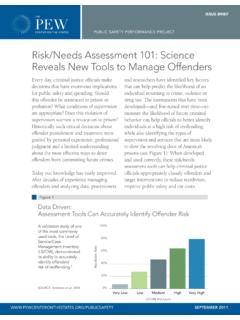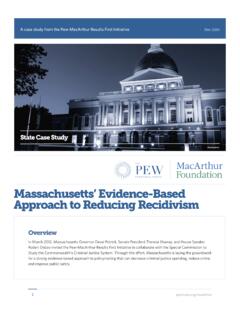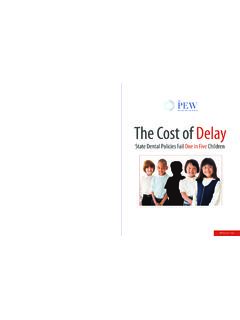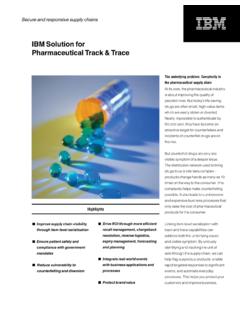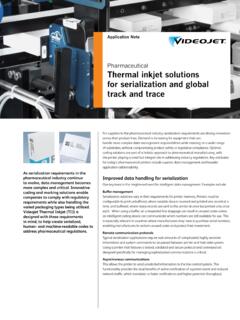Transcription of Implementing a Pharmaceutical Serialization and ...
1 Implementing a Pharmaceutical Serialization and Traceability System in the United States:Stakeholder Perspectives and InvestmentsiTable of Contents Table of ContentsExecutive Summary ..1 Key Findings and Respondent Preferences ..31. Overview and Scope .. Risks to the Pharmaceutical Supply .. Pharmaceutical Serialization and Traceability Systems .. What Are Serialization and Traceability Systems? .. Legislative and Regulatory Background ..82. Methodology .. Overview .. Data Collection and Analysis .. Questionnaire Issued to Supply Chain Stakeholders.
2 Follow-Up In-Depth Interviews with Supply Chain Stakeholders .. In-Depth Interviews with Technology Vendors .. Cost Analysis .. Study Limitations ..143. Supply Chain Stakeholder System Preferences and Perspectives .. Overview .. Respondent Demographics and Sector Descriptions .. Perspectives on Motivations, Necessity, and Prioritization .. Desire for Clarity on System Structure and Expectations .. System Preferences .. Supply Chain Partner Participation .. Drug Traceability and Authentication Preferences .. Traceability Data Storage and Transmission.
3 Inference and Aggregation ..244. Manufacturer Implementation and Costs .. Implementation Status .. Manufacturer Implementation Progress Compared to Other Supply Chain Sectors .. System Functionality Being Implemented by Manufacturers .. Manufacturer Costs .. Total Average Costs for a Medium-Sized Manufacturer Reported by the Manufacturing Sector and Vendors .. Costs Reported by the Manufacturing Sector .. Manufacturing Sector Costs Reported by Vendors .. Line, Site, and Enterprise Costs .. Incremental Costs of Aggregation and Data Sharing ..32 Aggregation.
4 33 Data of Contents5. Wholesaler and Dispenser Implementation and Costs .. Wholesaler Costs .. Costs Reported by the Wholesale Sector .. Wholesale Sector Costs Reported by Vendors .. Dispenser Costs ..376. Implementation Challenges and Benefits .. Challenges .. Internal and External Barriers to Implementation .. Internal and External Capacity Needs Availability of the Solution Provider Industry .. Data Protection .. Benefits ..447. Conclusion ..47 Appendix A: Supply Chain Stakeholder Questionnaire ..49 Appendix B: Follow-Up Interview Guide ..83 Appendix C: Cost Spreadsheet Template for Vendor Interviews.
5 85 Appendix D: Technology Increments ..91 Appendix E: Manufacturer Labor Costs ..95 Appendix F: Glossary ..97 Acknowledgements ..99 End Notes ..1011 Executive SummaryExecutive Summary2 The Pharmaceutical supply is considered one of the world s safest, and the distribution system is well regulated. Deficiencies and gaps persist, however, allowing unsafe medicines to be knowingly introduced into legitimate channels of commerce. Compromised Pharmaceutical products recently identified in the drug supply chain include drugs that have been stolen, diverted, or purchased illegally, as well as outright counterfeit, substandard, and contaminated versions of critical Breaches in the drug distribution system pose health risks to patients and financial risks to supply chain stakeholders and taxpayers.
6 In 2012, for example, the Attorney for Southern New York uncovered a significant drug diversion and resale scheme that cost the New York Medicaid program more than $500 million and put untold numbers of patients at risk from compromised 2012, the Food and Drug Administration (FDA) issued a warning to health care providers and patients that a counterfeit version of Avastin , a cancer drug, was missing its active ingredient and might have been purchased by a number of medical practices in California, Texas, and Regulators later determined that the fake drug was introduced into the United States through a series of wholesalers.
7 More counterfeit cancer drugs have since been discovered in the United Landmark federal legislation was passed to help address these risks in November of 2013. The Drug Quality and Security Act establishes a national electronic system to trace and verify unique, serialized packages of medicine as they move from the Pharmaceutical manufacturer through wholesalers to the pharmacy. Both state and federal regulators have sought to advance such measures for many years and, prior to the passage of the federal law, companies were preparing to comply with a similar electronic drug tracking requirement set by the state of California.
8 Regulators are now preparing to work with affected drug supply chain stakeholders to implement the federal law and develop technical guidelines for its operation. However there remains a lack of credible public information on stakeholder preferences across sectors on the optimal features of a Serialization and traceability system and the anticipated investments needed to implement such a system. To address this information gap, Booz Allen Hamilton and The Pew Charitable Trusts jointly conducted a qualitative assessment of stakeholder perspectives across the Pharmaceutical distribution supply chain, including the manufacturing, wholesale, and dispensing sectors.
9 An online questionnaire and in-depth interviews were conducted prior to the passage of the Drug Quality and Security Act, to gather information from members of the supply chain, as well as from the vendor technology industry that supports them. The responses are aggregated, and the companies are not analysis offers a unique, high-level snapshot of industry investments, expectations, and system preferences to inform implementation of the Drug Quality and Security Act. It will help regulators understand industry perspectives, and shed Executive SummaryCrackdown on Medicaid Fraud and Diverted Prescription Drugs The scheme to collect, aggregate, and resell costly prescription drugs was bad medicine in three ways: profiting so obscenely by breaking the law is the very definition of unjust enrichment.
10 The scheme was theft, plain and simple, from a program funded by taxpayers. And the scheme posed serious health risks at both the collection and distribution ends. People with real ailments were induced to sell their medications on the cheap rather than take them as prescribed, while end-users of the diverted drugs were getting second-hand medicine that may have been mishandled, adulterated, improperly stored, repackaged, and expired. 3 FBI Assistant Director in Charge Janice K. Fedarcyk, as quoted in a press release from the Attorney s Office that announced Medicaid fraud charges involving the diversion and trafficking of prescription drugs (July 2012)Executive Summary3 Executive Summarylight on the steps the FDA and supply chain businesses from manufacturers to pharmacies must take as they put new protections in place to maintain safety and security in the nation s drug supply.

